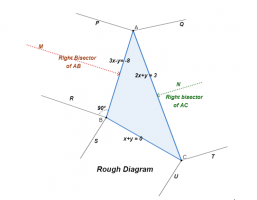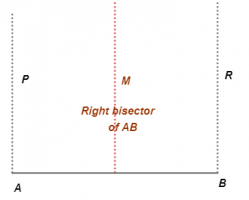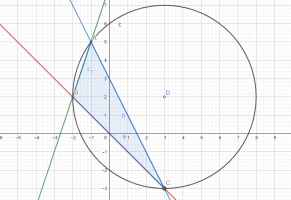I have now adopted an unusual method for solving this problem. I have tried to solve it at least for 3 times, but am getting wrong answer. My method is as follows -
If two lines with Equation E1 and E2 intersect, then equation of a third line passing through this point of intersection will be given by :
E1 + Φ E2 = 0. where Φ is a constant. Refer to the following figure -

Consider Joint A .
Any arbitrary line passing through A must have equation -
(3x-y+8) + Φ (2x+y-3) = 0
=> (3+2Φ) x + (Φ-1) y + (8-3Φ) = 0 ............... (1)
This line has slope = (3+2Φ)/(1-Φ)
This line will be perpendicular to AB, if it's slope = - 1/3
=> (3+2Φ)/(1-Φ) = - 1/3
=> Φ = -2
Hence Equation of this perpendicular line ( let's call it P ) will be : x(3-4) + y(-1-1) + (8+6) = 0
=> Equation of P : - x - 3y+14 = 0
=> x + 3 y = 14
Similarly Equation of Q will be obtained by keeping Φ=1/2
WE CAN, THUS FIND OUT EQUATION OF R,S,T and U
Now consider side AB. It has Two perpendiculars (P and R) at it's two ends. with known equations

These equations must differ by a constant. So we can find out equation of another perpendicular on the mid point of AB (shown by RED). It's equation must have constant = average of constant of P and R.
According to my calculations it comes out to be 9.
So equation of right bisector of AB will be : x+3y=9
Thus after knowing equation of any two right bisectors, Coordinates of circumcenter can be obtained.





